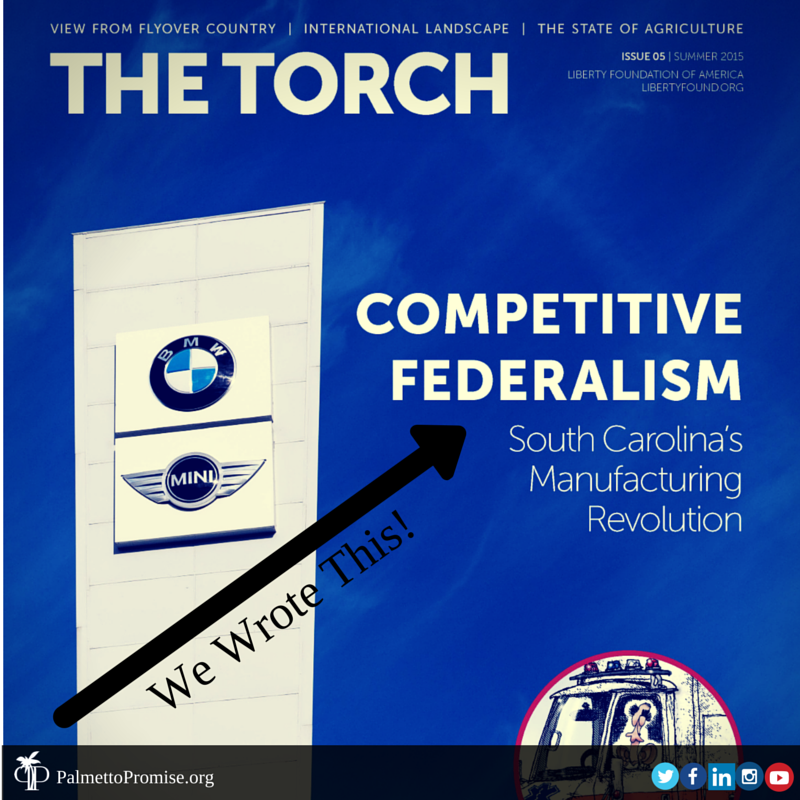South Carolina’s Manufacturing Revolution

Ellen Weaver
Great golf, gorgeous beaches, spicy shrimp and grits, and tea so sweet it’ll knock you into next Tuesday: welcome to South Carolina! But if you listen carefully, above the idyllic lull of the Atlantic waves, you’ll hear the hum of engines as a Palmetto State manufacturing powerhouse roars to life.
Since January 2011, manufacturing jobs in South Carolina have grown at 13.5 percent, nearly double the 7 percent average of our Southeastern neighbors, with a record high $29.7 billion in merchandise exports last year.
Manufacturing job creation has exceeded 200,000 new jobs every year since 2006, with major announcements from Boeing, Bridgestone, Michelin, Giti Tire, Continental, Daimler, and BMW, just to name a few. In fact, in 2013, South Carolina passed up Oklahoma and Ohio as the nation’s leading tire producer and exporter. And scuttlebutt has recently been centered on another “whale” that may be surfacing as Volvo shops for a home for a new American plant.
Despite economists’ warnings of a “leveling-off” period to all this growth due to a strengthening dollar, rising interest rates, and a natural slow-down of the pent-up post-recession expansion (they don’t call economics the dismal science for nothing, after all), things continue to look cheery across the South.
There is no question that the Southeast—and South Carolina specifically—has been a huge beneficiary of the key underlying premise of Competitive Federalism: as Rust Belt states have taxed, regulated, and unionized manufacturers to death, states like South Carolina have opened their arms.
There are many factors to South Carolina’s success story, including being located in a logistics sweet spot on the I-95 corridor and home to an exceptional deep-water port. But like most generational changes, it started with a visionary leader who refused to take “no” for an answer.
Leadership
The final two decades of the 20th century saw the completion of the long, painful decline of South Carolina’s once ascendant textile industry as these jobs migrated offshore in search of cheaper labor. Companies that failed to innovate died. And many towns in South Carolina’s Upstate—once the textile capital of the world—languished with little hope of a brighter future.
Enter Governor Carroll Campbell. Under his tireless leadership and aggressive salesmanship, South Carolina recruited BMW in the mid-90’s, joining Michelin—the granddaddy of South Carolina’s tire empire, which opened in 1975—to create an automotive cluster that caught the attention of other major tire manufacturers. This marked the rebirth of South Carolina manufacturing—and indeed the economy of the entire state—and has been the driving force behind South Carolina’s auto industry and export revolution ever since.
Workplace Freedom
South Carolina’s right-to-work law dates to 1954. Since then, it has served as an attractive calling card for business.
As Michelin North America CEO Pete Selleck observed, “There is no significant difference between nonunion and unionized plants other than a rule book in our unionized plants that tells us what we can and can’t do,” adding that the state “is also one of the least unionized states in the country, which gives us the flexibility to focus on the customer.” (And while Michelin does not disclose its average pay, industry observers say the company pays about $20 an hour, higher than the $15 an hour entry-level wages of union tire makers.)
In recent years, South Carolina has also served as ground zero in a high-profile fight between Boeing and the International Association of Machinists (IAM). Escalating labor costs and lost production time due to strikes had led Seattle-based Boeing to consider alternative locations for its new 787 Dreamliner production line.
With a Charleston plant already doing fuselage assembly, South Carolina was a natural place for Boeing to look. And in a show of the Palmetto State’s fighting spirit, plant workers—who had previously expressed dissatisfaction with the IAM’s representation—voted decisively to decertify the union.
But as ground was broken on the new line, the highly politicized Obama National Labor Relations Board took up the IAM’s frivolous complaint, claiming that Boeing’s decision was purely retaliatory against the Seattle workers, and calling the right of the company to locate in a right-to-work state into question. After furious back and forth in which the IAM tried to bar the Charleston plant from opening, the complaint was “miraculously” dropped when Boeing reached an agreement with the IAM to locate another line in Seattle.
And now, in an audacious bit of cheek, the IAM (with its shady tactics) is back in South Carolina, petitioning to represent the very workers whose jobs they originally tried to destroy! Thankfully, it appears that South Carolina workers get the joke, with recent reports that the IAM may be forced to withdraw its petition for lack of support.
Technical Education
South Carolinians’ “can do” optimism is captured in the state motto, “While I breathe I hope.” This— paired with our state’s other motto—“Prepared in mind and resources”—creates a powerful 1-2 punch and is reflected in the state’s robust and responsive system of technical community colleges, which date back to the 1960’s.
As many American students continue to rack up incredible amounts of education debt for four-year degrees that may or may not be aligned with the needs of a future workforce, South Carolina’s technical schools are preparing students for tech-savvy factory jobs and working directly with manufacturers to train students in needed skills and pair them with apprenticeships, and eventually employment opportunities.
Visit the shiny BMW plant—which looks more like a scene out of Transformers with all its moving robotic equipment than a car factory—as they roll out their sleek, 100% customized X models. Or watch as a massive lathe wraps a Boeing 787 plane fuselage with advanced carbon fibers, and you quickly see that these are not your grandfather’s manufacturing jobs. These highly automated plants require highly skilled workers, and South Carolina’s technical colleges are leading the way to supply them.
Sustaining the Momentum
But as well as South Carolina has done, if we’re going to maintain and expand this growth for the long term, we can’t be content to rest on our laurels.
As states like Michigan and Wisconsin discover the secret sauce of right-to-work, we’re losing that competitive advantage. And in the most recent release of the Rich States, Poor States Economic Competitiveness Index, while our current performance puts us at #20, our outlook has fallen to #32, largely based on our levels of debt and an uncompetitive tax structure.
Comprehensive tax reform is the single greatest next step we could take to ensure a bright outlook for South Carolina’s future. Our top marginal personal income tax rate is the highest in the Southeast. And while our corporate tax rate of 5% is one of the lowest in the nation, we exempt more corporate income than we collect—the financial incentives underbelly of South Carolina’s manufacturing recruiting success—with the majority of credits accruing to larger, newer companies rather than smaller, older in-state companies. This imbalance cannot be sustained indefinitely and is not a long-term strategy for economic competitiveness.
South Carolina’s lagging K-12 education performance must also be addressed through parental choice and robust accountability for spending if the Palmetto State is to continue to compete for the increasingly complex manufacturing jobs of the future.
Like in manufacturing, “continuous quality improvement” is the name of the state policy game if South Carolina is to hold and expand the incredible gains we’ve made in the last 30 years. This is the strategic, opportunity-generating work before the Palmetto Promise Institute. Bring on the challenge!





